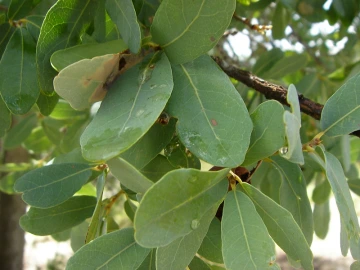
Anthony Mendoza Flickr.com
Botanical Family: Fagaceae
Scientific Name: Quercus oblongifolia
Common Names: Mexican blue oak
Botanical Description:
Quercus oblongifolia is a small, mid to high elevation (2,500-9,000ft), evergreen tree, often with many contorted branches, and a round spreading crown, growing to 10 meters in height (1,2). However, it is typically encountered as a shrub at the upper end of its elevation range (1,2). The bark is light gray to white and deeply furrowed, sometimes described as checkered (2,3). Young branches are glabrous (wax-coated) and gray to reddish-brown in color (2). Buds are 1-2 mm in size, ovoid in shape, with scales glabrous or pubescent, and with persistent stipules around the terminal buds. The blue-green leaves, which are 4-11 cm long, are oblong or lanceolate in shape, and are held by short, 2-5 mm petioles (2,3). The undersides of the leaves have a prominent midvein and densely white stellate-tomentose hairs with young leaves appearing woolly (2). Flowers born from March to May, are unisexual, and wind-pollinated, with staminate flowers being catkins, having reduced or absent petals, and 4-12 stamens (2). Pistillate flowers are solitary or born in clusters of 3 or more on spikes. The pistillate flowers develop into a woody cupule (cup-shaped structure) that encloses about 1/3 of the fruit (2). The fruits are1-1.5 cm long acorns that mature in autumn. (2,6).
Ecological Significance:
Quercus oblongifolia is a dominant species in lower oak woodlands in southern Arizona that cedes dominance to other species at higher elevations. It thrives in a wide range of habitats and has exceptional drought and heat tolerance. It is often found in association with Quercus emoryi and Quercus arizonica (1,4). Oaks (Quercus spp.) are keystone species, supporting important food chains and ecological processes. They provide sustenance and shelter for a multitude of animals, plants, fungi, and insects (4,5). Their shade canopy and root systems support soil microbes and invertebrates as well (4,5).
Ethnobotanical Value:
Quercus spp. are important medicinal plants widely used in traditional medicine (7). Nearly all parts of the plants, including fruit, bark, and leaves, possess medicinal properties. Indigenous tribes used the plant as an antiseptic, and for treatment of gastrointestinal tract disorders (7). The bark, prepared as a tea for internal use, or an ointment for topical application, purportedly has antiseptic properties, and is used as a blood-clotting agent, and in the treatment of toothaches, inflammation, and burns (7,8,9). However, further research is necessary to confirm these benefits and identify all possible side effects of use (9).The fruit is a rich source of nutrients, containing high levels of carbohydrates, proteins, amino acids, lipids, and sterols (7).
Distrubition:
Arizona, New Mexico, Texas, and Northern Mexico (Baja California, Sonora, Chihuahua, and Coahuila)

